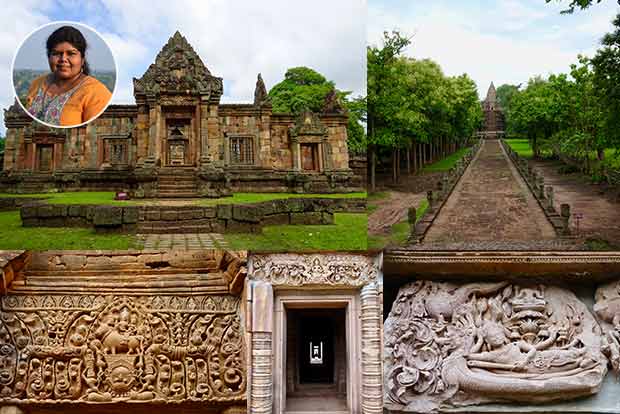Begin typing your search...
Travel through Thailand’s historical park with temples
The two temples — Prasat Phanom Rung and Prasat Muang — are century old with roots and architecture linked to south Indian shrines.

Chennai
Thailand is known for its beaches and parties but not many know about the architectural brilliance of the country. Towards the east side of the country lies a historical park containing ruins from the 10th century. A historical park with temples that are older than what is found in Angkor Wat of Cambodia. Temples that are century old with roots and architecture linked to south Indian temples. These temples — Prasat Phanom Rung and Prasat Muang Tam — represent stories from Hindu mythology in the land of Buddhism.
Both the temples have their roots from the Khmer empire, popularly known as the Angkor empire. Hence a lot of people assume that only Cambodia falls under them. However, the Khmer empire was spread across Thailand, Laos and parts of Myanmar and Vietnam, too. If we read the history of Khmer dynasty it is quite interesting. Khmer kings started out to be strong followers of Vaishnavism and with time they oscillated towards Shaivism.
So, we can see a lot of Vishnu and Shiva temples. In fact, it is fascinating to read that the Khmer kings made an alliance with the Chola dynasty of south India just because both were staunch followers of Shaivism. Subsequent kings started to adopt Buddhism, leading to Hindu temples being converted to Buddhist ones. Hence even now one can see some of the ancient sites of Thailand having lintel and motifs of Hindu Gods but the primary deity will be Buddha.
The countryside of east Thailand reminded me of rural India — residential houses on both sides, petty shops and small grocery shops tucked in the corners and street vendors selling fruits. Driving away from the town, led us to lush paddy fields on either side, tiled farmhouses tucked here and there with bullock carts in front of them, the cows lazing in the farm, hen and chicks were running around. Quite an offbeat site with very fewer tourists, the people were simple and helpful in all ways.
The first temple complex to visit was Phanom Rung. It was constructed by Suryavarman II, who was a Shiva devotee and hence the main deity of the temple is Lord Shiva. The temple is set on the rim of an extinct volcano and this hill is believed to represent Mount Kailash. Walking up the steep stairway, there comes the first sight of Phanom Rung at a distance.
The blue sky, the earthy tones of sandstone structure, green trees, the temple atop — indeed it looked like kailasam, the perfect adobe for Lord Shiva. Khmer architecture of temples is heavily influenced by the Indian temple architecture. These temples have a main entrance facing east with a gopuram towering above the entrance. And then there is the enclosure which usually has the temple pond, kitchen, dharamsala (for travellers to rest), a library (to stock religious scriptures), dancing hall, smaller shrines around the enclosure and the main sanctum where the primary deity resides.
One can see the Shiva linga from the entrance itself. The temple has an entrance on all four directions and you can see the Shiva linga from all sides. What fascinates me are the stories from Mahabharata and Ramayana on the lintels and walls. The main entrance has the sculpture of Dakshinamurthy on top — the representation of Lord Shiva as the supreme guru of all kinds of knowledge. The most famous lintel of Phanom Rung is the Phra Narai Lintel which depicts Vishnu in the ananthasayanam form (meaning, he is sleeping with Adhiseshan guarding him and goddess Lakshmi by his side).
In Thai, this posture is called Thap Lang Narai Banthomsin. The lintel was damaged and the head of Lord Brahma was missing and we could only see the hand of goddess Lakshmi near his feet. Phanom Rung festival is celebrated here annually, drawing a huge crowd. It is an architectural wonder when the sun aligns through all the 15 doors of the temple. It is a spectacle to watch!
The next temple to visit was the Prasat Muang Tam dedicated to Lord Shiva. This temple is well maintained and the lintels and motifs seem to be in better shape than Phanom Rung. With similar architecture, what captured my eyes are the lintels depicting scenes from mythology. Particularly the one that read Kalyana Sundara Murthy — Tamilians will find the term familiar. That is the form of Shiva where he marries goddess Parvathy. In this lintel, we can see them sitting on Nandi, the vehicle of Lord Shiva.
Both these temples are just kilometres apart. There are no places of stay around Phanom Rung. You can either stay at Buri Ram which is about 60 km away or at Nang Rong which is 30 km away. Bikes are available for hire and one can go around visiting these temples and a few smaller ones around on bikes. You can also hire a car for rent. The temples require about a little more than half a day to explore. Also, don’t forget to collect souvenirs from the shops in front of the temple.
(As told to Merin James)
Visit news.dtnext.in to explore our interactive epaper!
Download the DT Next app for more exciting features!
Click here for iOS
Click here for Android
Next Story



